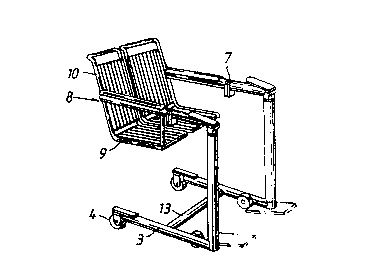Some of the information on this Web page has been provided by external sources. The Government of Canada is not responsible for the accuracy, reliability or currency of the information supplied by external sources. Users wishing to rely upon this information should consult directly with the source of the information. Content provided by external sources is not subject to official languages, privacy and accessibility requirements.
Any discrepancies in the text and image of the Claims and Abstract are due to differing posting times. Text of the Claims and Abstract are posted:
| (12) Patent Application: | (11) CA 2095694 |
|---|---|
| (54) English Title: | WHEELCHAIR WHERE THE SEAT IS DIVIDED LONGITUDINALLY |
| (54) French Title: | FAUTEUIL ROULANT A SIEGE DIVISE LONGITUDINALEMENT |
| Status: | Deemed Abandoned and Beyond the Period of Reinstatement - Pending Response to Notice of Disregarded Communication |
| (51) International Patent Classification (IPC): |
|
|---|---|
| (72) Inventors : |
|
| (73) Owners : |
|
| (71) Applicants : | |
| (74) Agent: | SMART & BIGGAR LP |
| (74) Associate agent: | |
| (45) Issued: | |
| (86) PCT Filing Date: | 1991-11-08 |
| (87) Open to Public Inspection: | 1992-05-09 |
| Availability of licence: | N/A |
| Dedicated to the Public: | N/A |
| (25) Language of filing: | English |
| Patent Cooperation Treaty (PCT): | Yes |
|---|---|
| (86) PCT Filing Number: | PCT/SE1991/000755 |
| (87) International Publication Number: | WO 1992008430 |
| (85) National Entry: | 1993-05-06 |
| (30) Application Priority Data: | ||||||
|---|---|---|---|---|---|---|
|
2095694 9208430 PCTABScor01
A wheelchair for handicapped people includes a frame structure
(1) which is carried by chair-rolling devices (4) and which in turn
carries a seat (8) and back-support (10). The wheelchair is
characterized in that the seat (8) is divided longitudinally,
preferably along a centre line, and in that the seat parts (9, 10) are
so journalled to the frame structure (1) as to enable the seat
parts to be swung outwardly on respective sides of the wheelchair,
independently of one another.
Note: Claims are shown in the official language in which they were submitted.
Note: Descriptions are shown in the official language in which they were submitted.

2024-08-01:As part of the Next Generation Patents (NGP) transition, the Canadian Patents Database (CPD) now contains a more detailed Event History, which replicates the Event Log of our new back-office solution.
Please note that "Inactive:" events refers to events no longer in use in our new back-office solution.
For a clearer understanding of the status of the application/patent presented on this page, the site Disclaimer , as well as the definitions for Patent , Event History , Maintenance Fee and Payment History should be consulted.
| Description | Date |
|---|---|
| Time Limit for Reversal Expired | 1998-11-09 |
| Application Not Reinstated by Deadline | 1998-11-09 |
| Deemed Abandoned - Failure to Respond to Maintenance Fee Notice | 1997-11-10 |
| Application Published (Open to Public Inspection) | 1992-05-09 |
| Abandonment Date | Reason | Reinstatement Date |
|---|---|---|
| 1997-11-10 |
Note: Records showing the ownership history in alphabetical order.
| Current Owners on Record |
|---|
| BENGT SODERLUND |
| Past Owners on Record |
|---|
| None |